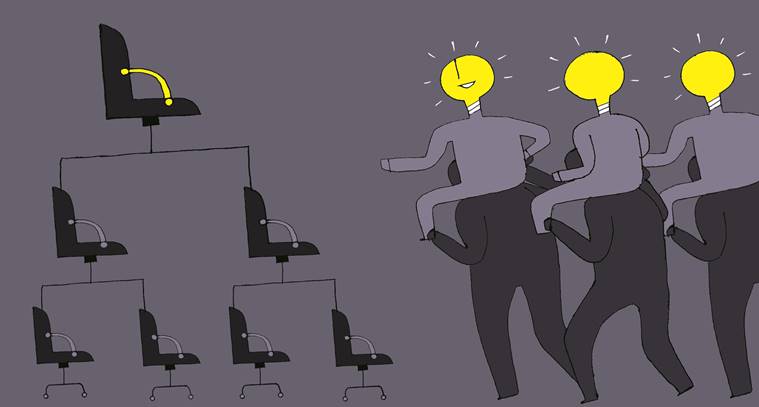Steel frame, more flexible
Recently announced lateral entry of 10 joint secretaries at the Centre is a remarkable opportunity to rethink the structure of the state and what we want from it.

The halo around the IAS is, of course, because of their immense power, the inherent unaccountability and aura of “superior understanding” or “merit” supposedly ensured by the difficulty and selectivity of the UPSC exam. This is the “iron cage” that we have inherited from the colonial, if not the Mughal, era. (Illustration: C R Sasikumar)
Every year with the onset of summer, thousands of villages across Maharashtra struggle to obtain drinking water. Temporary solutions include waiting for water tankers, buying expensive “jar” water or relocation. The immediate reason for this is the failure of an important public good — the public water supply system. Other development sectors also face a similar affliction, for example, severe malnutrition in tribal areas despite the presence of anganwadis or an inefficient public transport service. The obvious questions are: Who is responsible? And what is to be done? Every five years, political parties try to convince us that it is their party that can solve these problems. Given the complexity of the situation, it is difficult to imagine this. Moreover, constitutionally speaking, at the state level, it is unclear if they are even empowered to do so.
Partly by law and partly by tradition, the states have been governed by the Indian Administrative Services (IAS). Barring exceptions, all posts from the district collector to the secretary of a department are reserved for IAS officers. The functioning of the state machinery, from the appointment of employees to disbursement of funds, requires the explicit approval of IAS officers. However, if the state wants to initiate disciplinary action against a particular officer, it requires the permission of the central government. It is therefore very difficult for the “provincial” representatives to take any disciplinary measure against IAS officers. The recently announced lateral entry of 10 joint secretaries at the Centre, is a remarkable opportunity to rethink the structure of the state and what we want from it.
IAS officers are selected through the Civil Services Examination (CSE) conducted by the UPSC. This exam is attempted by lakhs of young people across the country from whom about 200-300 trainee officers are selected. However, there is little rigorous or sectoral training after selection. The halo around the IAS is, of course, because of their immense power, the inherent unaccountability and aura of “superior understanding” or “merit” supposedly ensured by the difficulty and selectivity of the UPSC exam. This is the “iron cage” that we have inherited from the colonial, if not the Mughal, era.
Let us now move to a typical department — the Water Supply and Sanitation Department in Maharashtra, which has more than 6,000 employees (including those employed by the zila parishad). Of these, more than 1,000 are engineers. The head of the department is the secretary, who is an IAS officer and whose typical term is of three years. As per the Constitution, the secretary is responsible for the smooth functioning of the entire department. This includes the day-to-day running, effecting improvements in its functioning and outcomes, making suitable suggestions to the minister, etc. However, there is no guarantee that the secretary has the required training, background or expertise in water management or enterprise management. This means that the entire department must rely on the long experience across departments and the “superior understanding” of the secretary. Any reform depends on the chance that the secretary is open to inputs from his subordinate senior managers.
The outcomes of such a system are obviously patchy. As per the NSSO Survey of 2012, only 74 per cent of the rural population of Maharashtra had access to drinking water throughout the year. The Census of 2001 and 2011 too show a deterioration in large parts of the state. However, around the same time, the department reports claim that the state had 85 per cent coverage by piped water supply schemes. The secretary seemed unaware of such a major discrepancy in numbers. Clearly, improvements in coverage and year-round access should have been the central objectives of the department. This was missed. Moreover, problems such as the drying up of groundwater sources, increasing levels of nitrate contamination in drinking water sources, and failure of major water supply schemes have been overlooked. The planning, design and test procedures being used by the engineers and geologists of the department are outdated. No thought has gone into this.
A similar situation is seen in other government departments as well. In fact, the antiquated job profiles of government servants and moribund senior administration are important reasons for a creeping privatisation and periodic freezes on state recruitments. They are also responsible for the absence of new professions, new research and smart companies in several key sectors such as water, public transport and logistics.
This calls for a drastic change in the structure of the department and the roles and responsibilities of IAS officers. The recently proposed lateral entry is one such mechanism at the Centre. We propose another at the state level. Every government department should create a new section called “Analysis and Research (AR)”, which is led by an officer at the level of a deputy secretary. The section should be adequately staffed at the division and district level and have its own guaranteed funding. The main task of the deputy secretary will be to prepare and maintain a detailed documentation of the working procedures within the department, analyse their outcomes and upgrade them, design monitoring and evaluation criteria, create a network of trusted knowledge institutions and undertake periodic and extensive evaluations, assessment and other topical research studies. In fact, the production of such periodic (say, biennial) public reports may be regarded as the chief responsibility of the deputy secretary.
Such reports will ensure that the people at large appreciate the scale of the problems and are mobilised to work towards their solution. It will also help students, researchers, funding agencies and industry to identify problem areas and come forward with possible approaches to bring improvements in the sector. In fact, the position of deputy secretary will likely attract young researchers, academics and professionals within that sector to work with the department on deputation, and such lateral entry at this and at the district level should be enabled. Through such give-and-take, the department will also forge collaborations with social and public institutions working in that sector. Without such research and knowledge sharing partnerships, it will be very difficult for the state to actually deliver on the many development needs of our people.
The roles and responsibilities of the political sphere and the administrative sphere are different. The inherent limitation of the administrative structure is an important cause of our stunted development. These difficulties cannot be overcome solely by the sincerity or hard work of political agents. What they can do is to bring about the necessary reform. And this is what we in the civil society should expect from our politicians.
Sohoni teaches at IIT Bombay and Dharap is a researcher.
For all the latest Opinion News, download Indian Express App
More From Milind Sohoni
- An artificial shortage of factsSteeped in elitism, our educational institutions discourage case studies. Government programmes remain unrelated to ground realities...
- Add science to tasteToday, various top universities are redefining engineering education, for instance, ‘Engineering+X’ at University of Southern California, or Development Engineering at UC Berkeley, and other innovative…







































No hay comentarios:
Publicar un comentario